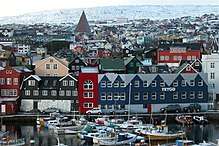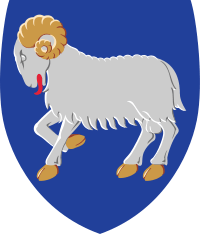Economy of the Faroe Islands
The economy of the Faroe Islands was the 166th largest in the world in 2014, having a nominal gross domestic product (GDP) of $2.613 billion per annum.[11] The vast majority of Faroese exports, around 90%, consists of fishery products.[12]
 Tórshavn is the capital and largest town of the Faroe Islands | |
| Currency | Faroese króna (pegged with Danish krone, (DKK)) |
|---|---|
| calendar year | |
Trade organisations | none |
| Statistics | |
| GDP | US$2.83 billion (2017)[1] |
| GDP rank | 166th (nominal) / 179th (PPP) |
GDP growth | 7.5% (2013 est.) |
GDP per capita | $54,833 (2017)[1] |
GDP by sector | agriculture: 16%, industry: 29%, services: 55% (2007) |
| 1.3% (2019) | |
Population below poverty line | 10.1% (2018) |
Labour force | 31,667 (2019)[4] |
Labour force by occupation | agriculture: 10.7%, industry: 18.9%, services: 70.3% (2010) |
| Unemployment | 1.7% in 2019 |
Main industries | fishing, fish processing, fish farming, small ship repair and refurbishment, handicrafts |
| External | |
| Exports | DKK 9.77 billion (2019-20) |
Export goods | fish and fish products 90%, stamps, ships |
Main export partners | |
| Imports | DKK 8.4 billion (2019-20) |
Import goods | consumer goods 24%, machinery and transport equipment 23.5%, fuels 21.4%, raw materials and semi-manufactures, fish, salt |
Main import partners | |
| Public finances | |
| $104.1 million (2018)[9] | |
| Revenues | $1.54 billion (2018)[9] |
| Expenses | $1.43 billion (2018)[9] |
| Economic aid | recipient: DKK 201 million (2018) (Danish state expenditure)[10] |
History
After the severe economic troubles of the early 1990s, brought on by a drop in the vital fish catch and poor management of the economy, the Faroe Islands have recently recovered, with unemployment down to 5% in mid-1998, and holding below 3% since 2006, one of the lowest rates in Europe.
Challenges and opportunities
Salaries by industry, 2019[13]
High dependence on fishing (including salmon farming) means the Faroe Islands' economy remains vulnerable. The Faroese hope to broaden their economic base by building new fish-processing plants. The islands allow up to 25% foreign ownership of ocean industry decreasing gradually until 2032 when foreign ownership must end.[14] Petroleum found close to the Faroese area gives hope for deposits in the immediate area, which may lay the basis for sustained economic prosperity. Also important are the annual subsidy from Denmark, which amounted to about 3% of the GDP.[15]
The Faroes have one of the lowest unemployment rates in Europe (1% in 2019),[16] but this is not necessarily a sign of a recovering economy, as many young students move to Denmark and other countries once they are finished with high school. This leaves a largely middle-aged and elderly population that may lack the skills and knowledge to take IT positions in business and industry. Since 2000, new information technology and business projects have been fostered in the Faroe Islands to attract new investment. The result from these projects is not yet known but is hoped to bring a better market economy to the Faroe Islands. The population was around 52,000 by 2019.[17]
General salaries increased from DKK 7 billion in 2013 to DKK 10 billion in 2019.[13]
Trade
In 2014 the Faroe Islands had a trade surplus of 401 million DKK,[18] a figure that rose to 1.43 billion DKK in 2016.[19] As of 2016, the Faroe Islands mainly imported goods from Denmark (2,467 million DKK), Germany (877 million DKK), and Norway (610 DKK).[8] The country's top export destinations were Russia (1,907 million DKK), the United States (898 million DKK), the United Kingdom (851 million DKK), and Denmark (697 million DKK).[6] European Union countries constituted 72.9% of total Faroese imports, while the exports of the Faroe Islands were more equally distributed between European Union (44.4%) and non-European Union countries (55.6%).[19] The vast majority of Faroese exports, around 90%, consists of fishery products.[12][20] Russian countersanctions on food imports from Norway and the European Union, saw the Faroe Islands increase its fresh salmon exports to Russia.[21][22][23] The Faroe Islands has a free trade agreement with Iceland since 2005.[24]
| Rank | Imports | Rank | Exports | ||
|---|---|---|---|---|---|
| Origin | Value | Destination | Value | ||
| 1 | 2,467 DKK | 1 | 1,907 DKK | ||
| 2 | 897 DKK | 2 | 898 DKK | ||
| 3 | 610 DKK | 3 | 851 DKK | ||
| 4 | 371 DKK | 4 | 697 DKK | ||
| 5 | 282 DKK | 5 | 569 DKK | ||
| 6 | 248 DKK | 6 | 521 DKK | ||
| 7 | 186 DKK | 7 | 460 DKK | ||
| 8 | 169 DKK | 8 | 369 DKK | ||
| 9 | 148 DKK | 9 | 284 DKK | ||
| 10 | 143 DKK | 10 | 251 DKK | ||
| – | 4,807 DKK | – | 3,561 DKK | ||
| – | Non-EU countries | 1,785 DKK | – | Non-EU countries | 4,461 DKK |
| – | Total | 6,592 DKK | – | Total | 8,022 DKK |
Energy
In 2014 217,547 tonnes of oil products were consumed in the Faroe Islands.[25] Of this 31.58% was consumed by fishing vessels, 14.73% was used by SEV for electricity production, 23.23% was consumed in air, sea or land transport, 9.6 was used in the industry, and the rest was used in public or private buildings.[25]
The islands have 6 hydroelectric plants,[26] 4 diesel plants[27] and several wind power plants with a capacity factor above 40%.[28] In 2014, a 12MW wind farm for DKK 180 million[29] became operational near Torshavn and increased wind capacity from 6.6 to 18.6MW. It decreases oil consumption by 8,000 ton (approximately 4M€) per year.[28] A 2.3MW 700 kWh lithium-ion battery[30] became operational in 2016.[31] Planners also consider converting the existing hydropower[32] to pumped-storage hydroelectricity.[29] Tidal power[33] and Thermal energy storage solutions are also considered.[34] The islands have a goal of 100% green electricity production by 2030.[29][35]
| External images | |
|---|---|
In 2014 and 2017[36] 50.8% of the electricity production of SEV in the Faroe Islands came from green energy like hydro and wind, while 49.2% was produced by the thermal power plants, which was 12.4% less than in 2013.[37]
- fossil fuel: 49.2%
- hydro: 39.5%
- wind: 11.3%% (2014)
- nuclear: 0%
Total annual production: 305.4 GWh (2014) of which the production of thermal, hydropower and wind power was:
- Thermal: 150,2 GWh
- Hydropower: 120,7 GWh
- Wind: 34,5 GWh
The Faroe Islands have no electricity connections to other areas, and thus operate in island condition. Some islands are also not connected to the other islands, and must maintain their own electric system.[38]
Other
Agriculture - products: milk, potatoes, vegetables; sheep; salmon, other fish
Currency: 1 Danish krone (DKr) = 100 ører
Exchange rates: Danish kroner (DKr) per US$1 – 5.560 (2008), 7.336 (January 2000), 6.976 (1999), 6.701 (1998), 6.604 (1997), 5.799 (1996), 5.602 (1995)
Further reading
- www.FaroeseSeafood.com - Information site on fisheries and aquaculture in the Faroe Islands
- Apostle, Richard A. The Restructuration of the Faroese Economy The Significance of the Inner Periphery. Frederiksberg, Denmark: Samfundslitteratur, 2002. ISBN 87-593-0891-5
- Elkjær-Hansen, Niels. The Faroe Islands Scenery, Culture, and Economy. Copenhagen: Royal Danish Ministry of Foreign Affairs, 1959.
- Hagstova.fo, 2008 figures
References
- "Main figures - Gross domestic product". Statistics Faroe Islands. 26 April 2019. Archived from the original on 12 November 2019. Retrieved 21 May 2020.
- "Changes in CPI, average annual inflation rate". Statistics Faroe Islands. Retrieved 21 May 2020.
- "Risk of poverty". Statistics Faroe Islands. Retrieved 21 May 2020.
- "Labour force". Statistics Faroe Islands. Retrieved 21 May 2020.
- "Exports exceed DKK 9 billion". Statistics Faroe Islands. 17 April 2020. Retrieved 21 May 2020.
- "Exports by country of final destination (1988-2016)". Statistics Faroe Islands. Retrieved 5 November 2015.
- "Total imports at DKK 8.4 billion". Statistics Faroe Islands. 17 April 2020. Retrieved 21 May 2020.
- "Import by BEC-groups, country of origin and months (1988-2017)". Statistics Faroe Islands. Retrieved 5 November 2017.
- "General government". Statistics Faroe Islands. 1 November 2019. Archived from the original on 12 November 2019. Retrieved 21 May 2020.
- "Danish state administration". Statistics Faroe Islands. 1 November 2019. Archived from the original on 12 November 2019. Retrieved 21 May 2020.
- "Gross domestic product 2014" (PDF). World Bank. 18 September 2015. Retrieved 12 October 2015.
- "Economy of the Faroe Islands". Visit Faroe Islands. Retrieved 18 January 2020.
- Djurhuus, Høgni (11 January 2020). "Salaries exceeded DKK 10 billion last year". Kringvarp Føroya (in Faroese).
- Hvidtfeldt, Jón Brian (23 December 2019). "Foreign ownership in fishery industry continues". Kringvarp Føroya (in Faroese).
- Information about the economy of the Faroe Islands
- Djurhuus, Høgni (13 January 2020). "Enough funds to cover 12 years of unemployment". Kringvarp Føroya (in Faroese).
- "Population now close to 52,000". Kringvarp Føroya (in Faroese).
- "Faroe Islands in Figures 2015" (PDF). Statistics Faroe Islands. Archived from the original (PDF) on 4 March 2016. Retrieved 5 December 2015.
- "Faroe Islands in Figures 2017" (PDF). Statistics Faroe Islands. Archived from the original (PDF) on 5 February 2018. Retrieved 5 November 2017.
- "Trade and Industry". VisitFaroeIslands.com. Archived from the original on 8 December 2015. Retrieved 5 December 2015.
- Pettersen, Trude (September 3, 2015). "Faroe Islands cashing in on Russian sanctions". Barents Observer. Retrieved 5 December 2015.
- Rutkowski, Lena (18 October 2015). "The Faroe Islands don't play by EU rules". The Murmur. Archived from the original on 8 December 2015. Retrieved 5 December 2015.
- "Faroe/Russian fishery agreement renewed". Kringvarp Føroya (in Faroese). 10 December 2019.
- Johannessen, John (29 December 2019). "Faroe/Iceland free trade deal renewed". Kringvarp Føroya (in Faroese).
- "Consumption of oil in tonnes by consumer groups". Statistics Faroe Islands. Retrieved 6 December 2015.
- Hydro electric power
- Thermal Power
- Terji Nielsen. Wind energy in the Faroe Islands Archived 2015-12-08 at the Wayback Machine page 19-21. SEV, 2015
- Green Progress
- "Faroe Islands to get Europe's first wind-connected battery storage system". Renew Economy.
- "Lithium-ion batteries can help to safeguard the grid". 8 November 2016. Retrieved 1 March 2017.
- Bárður A. Niclasen. Vedvarende energi Archived 2015-12-08 at the Wayback Machine 2015
- Tidal Energy on the Horizon
- Jannicke Nilsen (27 November 2015). "ENERGYNEST - THERMAL ENERGY STORAGE - TES". Teknisk Ukeblad.
- "100by2030". SEV. Retrieved 1 March 2017.
- http://www.sev.fo/Default.aspx?ID=193&Action=1&NewsId=3008&M=NewsV2&PID=392
- "SEV - Framleiðsluroknskapur 2014 Production Accounts 2014" (PDF) (in Faroese and English). SEV. Retrieved 25 September 2015.
- SEV recommends wind turbines for Suðuroy
External links
- Faroese banknote series Information about Faroese banknotes
